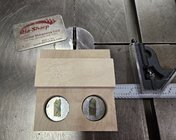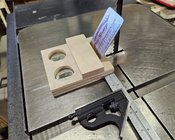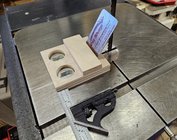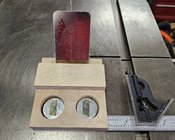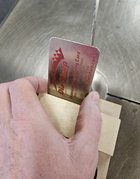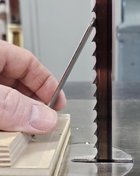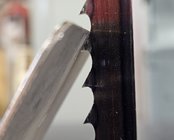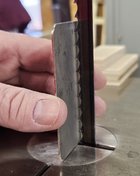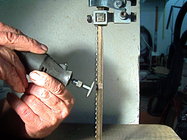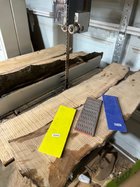I have two bandsaws, an old Powermatic 14” and a used Rikon 18”, for preparing bowl blanks and other lathe related projects.
A while back I searched the internet for ways to sharpen bandsaw blades that didn’t require removing the blade from the saw. Using a flat cutting disk on a Dremel and carefully touching the top of each tooth was the most promising and certainly has proven to be the most effective method for me.
But it’s time consuming and requires power equipment. I still wondered if there was a method to do so without taking off the blade and without using power equipment.
I couldn’t find any online, so I sat and stared at my bandsaw and cogitated and ruminated and pondered.
Then I came up with this idea.
UNPLUG THE SAW.
Hold a diamond card up to and parallel with the top edge of the teeth on the band saw blade, push it against that surface, and simply rotate the blade backwards using the upper wheel. Repeat until sharp. I used a 400 grit diamond credit card file.
For me it works, as well as for everyone else who has commented on the quick video I made. (My little channel isn’t monetized and won’t be, so I’m not trying to drive traffic there for hits. I just think this is a good idea.)
If you see any serious problems with this idea, please let me know.
A while back I searched the internet for ways to sharpen bandsaw blades that didn’t require removing the blade from the saw. Using a flat cutting disk on a Dremel and carefully touching the top of each tooth was the most promising and certainly has proven to be the most effective method for me.
But it’s time consuming and requires power equipment. I still wondered if there was a method to do so without taking off the blade and without using power equipment.
I couldn’t find any online, so I sat and stared at my bandsaw and cogitated and ruminated and pondered.
Then I came up with this idea.
UNPLUG THE SAW.
Hold a diamond card up to and parallel with the top edge of the teeth on the band saw blade, push it against that surface, and simply rotate the blade backwards using the upper wheel. Repeat until sharp. I used a 400 grit diamond credit card file.
For me it works, as well as for everyone else who has commented on the quick video I made. (My little channel isn’t monetized and won’t be, so I’m not trying to drive traffic there for hits. I just think this is a good idea.)
If you see any serious problems with this idea, please let me know.

